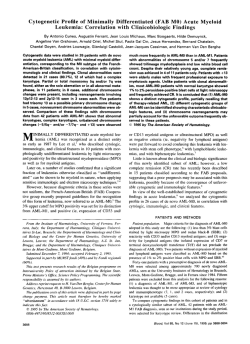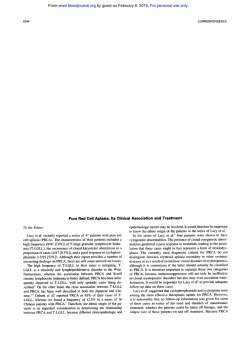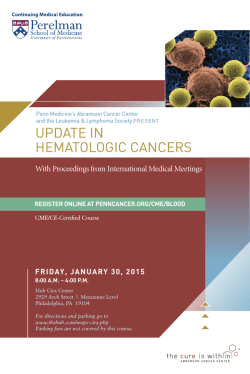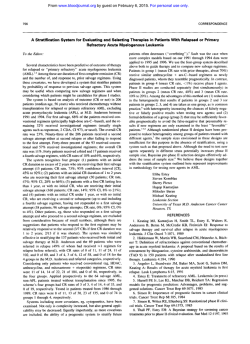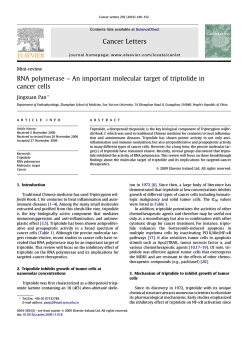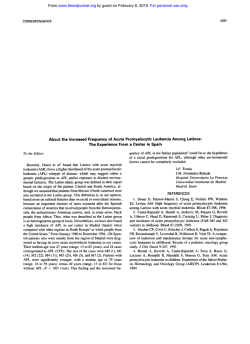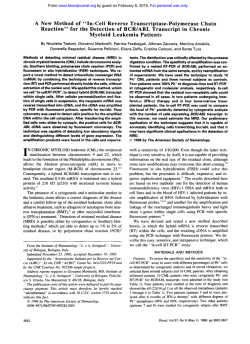
Homoharringtonine Therapy Induces Responses in Patients
From www.bloodjournal.org by guest on February 6, 2015. For personal use only. Homoharringtonine Therapy Induces Responses in Patients With Chronic Myelogenous Leukemia in Late Chronic Phase By Susan O’Brien, Hagop Kantarjian, Michael Keating, Miloslav Beran, Charles Koller, L.E. Robertson, Jeane Hester, MaryBeth Rios, Michael Andreeff, and Moshe Talpaz Homoharringtonine (HHT) is a plant alkaloid with potentmyelosuppressive activity and little toxicity when used in a continuous infusion schedule. The antileukemic efficacy of HHT has been shown in acute myeloid leukemia, but has not been investigated in chronic myelogenous leukemia (CML). Seventy-one patients with Philadelphia chromosome-positive Ph’) CML in late chronic phase (time fromdiagnosis to therapy longer than 12 months) were treated with a continuous infusion of HHT at a daily doseof 2.5 mg/m2 for14 days for remission induction and for 7 days every month for maintenance. The median number of courses given was 6 (range, 1 to 35) and 21 patients (30%)continue on treatment. Forty-two of 58 patients 172%) evaluable for hematologic response achieved a complete hematologic remission, and 9 (16%) had a partial hematologic remission. Twenty-two of 71 patients (31%) developed a cytogenetic response; it was major (Ph’ cells lessthan 35%) in 11 (15%) and complete (Ph’ cells 0%) in 5 (7%). Significant myelosuppression occurred in 39% of induction courses and 9% of maintenance courses. Fever ordocumented infection was present in 26%of induction courses and in only 8% of maintenance courses. Nonmyelosuppressive toxicity was minimal. Homoharringtonine produced hematologic remissions in themajority of patients with advanced chronic-phase CML. Cytogenetic response occurred in some patients without an association with m y elosuppression, and these responses may beprolonged. Future studies investigating homoharringtonine in combination withother active agents in CML, such as interferon, are warranted. 0 1995 by The American Society of Hematology. A harringtonine was first used in the treatment of leukemia by the Chinese, who reported activity in both acute myelogenous leukemia (AML) and CML.‘.” Cytogenetic responses were not described in those studies. Subsequent phase I studies in the United States usingabolus schedule of HHT showed hypotension and myelosuppression to be the doselimiting toxic effects.’.* To abrogate the hypotensiveside effects, HHT was given as a continuous infusion for AML, and occasional responses were seen.”” However, hypotension still occurred frequently at daily doses above S mg/m’. Using a lower daily dose of 2.5 mg/m2 and prolonging the infusion to 14 to 2 1 days reduced the incidence rate of hypotension to only 3% and with this schedule, the only doselimiting toxic effect was prolonged myelosuppression.” Because of its potent myelosuppressive effects, weinvestigated HHT in the treatment of CML. Study patients were ineligible for related BM transplants and in most cases had failed to respond to therapy with IFN-a. Herein, we describeour resultsusing HHT in patients with CML in late chronic phase. LLOGENEIC BONE MARROW (BM) transplantation is curative in patients with chronic myelogenous leukemia (CML), but is limited to only 20% of patients because of restrictions on age and donor compatibility.’Interferon a (IFN-a) treatment in early chronic-phase CML results in a hematologic response in 70% to 80% of patientsand in complete suppression of the Philadelphia chromosome (Ph), or complete cytogenetic response, in15% to 25% of patients.* These complete cytogenetic responses are long lasting, with 80% of patients remaining alive and in remission at 8 years.3 Confirmation that the survival benefit is conferred by the cytogenetic response hasbeen shown by landmark analysis that analyzed survival from 12 months into therapy by response at 12 months; and by multivariate analysis that identified major cytogenetic response (introduced as a time varying factor afterpretreatmentprognosticfactors were identified) to be an independent prognostic factor for survival.’ An Italianrandomizedstudy also showed by landmark analysisthe prognosticsignificance for survival of achieving a cytogenetic response with IF’N-o~.~ When the CML becomes resistant to IFN-a, therapeutic options are limited, and palliative treatment such as hydroxyurea is commonly used. Based on the hypothesis that suppression of the Ph chromosome will prolong survival, we have searched for other agentsthat can produce bothhematologic and cytogenetic remissions in CML. Homoharringtonine(HHT) isaplantalkaloidderived from the Cephalotuxus fortuneii tree. A mixture of HHT and From the Department of Hematology, The Universit). of Texas MD Anderson Cancer Center, Houston. Submitted October 6, 1994; accepted June 28, 1995. Address reprint requests to Susan O’Brien, MD, Department of Hematology, Box 61, The University of Texas MD Anderson Cancer Center, 1515 Holcomhe Bfvd, Houston, 7x 77030. The publication costs ofthis article were defrayed in part by page chargepayment. This article must therefore he herebymarked “advertisement” in accordance with 18 U.S.C. section 1734 solely to indicate this fact. 0 1995 by The American Society of Hematology. 0006-4971/95/8609-0034$3.00/0 3322 PATIENTS AND METHODS Study population. Seventy-one patients with CML in late chronic phase (defined as a period from diagnosis to therapy longer was than 12 months)weretreatedafterwritteninformedconsent obtained according to institutional guidelines. The 12-month treatment cut-off was chosen based on known differences in response to therapy of CML patients beyond this point. Patients with a disease duration of more than I year have inferior hematologic and cytogenetic response rates to IFN-u.”.’‘ Similarly, patients with CML who receive an allogeneicBM transplant at morethan I year from diagnosis have significantly inferior survival compared with those patients transplanted within 1 year.’ a Zubrod performance status Treatment eligibility criteria included 5 2 andnormal renal andhepaticfunctions.Patientswithsevere heart disease (cardiac classes 111 and W ) were excluded. Patient characteristics are outlined in Table I . The median patient age was 46 years (range, 23 to 71 years), and 48% were women. a Zubrodperformancestatus 5 1 . The Allbutthreepatientshad median time from diagnosis of CML to treatment with HHT was 37 months (range,4 to 188 months). Five patients (7%), weretreated within I year of diagnosis.all of whomhadpreviouslyreceived Blood, Vol 86, N o 9 (November l), 1995:pp 3322-3326 From www.bloodjournal.org by guest on February 6, 2015. For personal use only. 3323 HOMOHARRINGTONINE IN CML Table 1. Patient Characteristics In = 711 Characteristic No. of Patients (Oh) ~~~~ Age >50 (yr) Time from diagnosis to HHT >3 yr Prior interferon therapy Interferon resistant Palpable splenomegaly Clonal evolution Disease status Active Hematologic remission, 100% Ph’ Patients with active disease (n = 58) WBC count >50 x 103/pL Platelet count >500 X 103/pL Hemoalobin <11.0 a/dL 46 (23-71) 37 (52) 58 (82) 41 (58) 18 (32) 20 (28) and no palpable splenomegaly. CHR was further classified according to suppression ofthePh chromosome as follows: no cytogenetic response, 100% Ph’ metaphases; minimal cytogenetic response, 35% to 95% Ph+ metaphases; partial cytogenetic response, 1% to 34% Ph’ metaphases; complete cytogenetic response, no Ph+ metaphases. Twenty metaphases were analyzed whenever possible (85% of analyses). Partial hematologic remission (PHR) required a peripheral WBC count c 10 X 10’/pL, and 2 50% reduction of palpable splenomegaly and thrombocytosis but residual immature cells were allowed. RESULTS 26 (45) 27 (47) 19 (33) IFN-a therapy; two had resistant disease, two had neurotoxicity, and one was in hematologic remission buthad never achieved a cytogenetic response. Of the 71 patients, 58 (82%) had previously received IFN-a therapy; 41 patients (58% of the total, 69% of the prior IFN-a treated) had documented hematologic resistance to IFNa. Fifty-eight patients (82%) treated had active disease, and their median hematologic parameters at the start of therapy were as follows: white blood cell (WBC) count, 43 X lO’/pL, (range, 3.7 to 237 X lO’/pL); hemoglobin level, 11.9 g/dL, (range 7.8 to 15 g/ dL); and platelet count, 426 X 103/pL, (range, 82 to 2,180 X 10’1 pL). Three (4%) of the 71 patients started HHT therapy with WBC counts below 10 X lO’/pL but were considered to have active disease because their platelet counts ranged from 688 to 2,005 X lO’/pL. Eighteen (32%) of the 58 patients had palpable splenomegaly, ranging from 1 to 20 cm below the costal margin. In all 58 patients with active disease, 100% of metaphases showed thePh chromosome. Sixteen (28%) of the 58 patients also had an additional clone in 4% to 100% of metaphases (median, 20%). Of 71 study patients, 13 (18%) were in hematologic remission, but had never achieved a cytogenetic response. Hematologic response to HHT could not beevaluated in those patients, but theywere included in the analysis for evaluation of cytogenetic response. All 13 of these patients had 100% Ph+ metaphases, and 4 of the 13 had additional clones. Therapy. Homoharringtonine was given as a continuous infusion through a central venous catheter at a daily dose of 2.5 m g h 2 over 14 days onan outpatient basis. Patients who achieved complete hematologic remissions received maintenance therapy with 2.5 mg/ m2 HHT for 7 days every month. In subsequent courses, the dose was held constant, but the number of days could be adjusted to achieve a nadir granulocyte count of about 1,00O/pLand a nadir platelet count above 50 X 103/pL. Courses were given at monthly intervals provided the granulocyte count had recovered to above 2,500/pL and the platelet count to above 100 X lO’/pL. Most patients who achieved remission did so with one 14-day course. Fourteen patients (20%) required two courses, four patients (6%) required three courses and one patient received five induction courses. The median time from the start of HHT therapy (14-day induction) to the maintenance courses was five weeks (range, 2 to 18). The median number of courses of HHT given was 6 (range, 1 to 3 3 , and 21 of the 71 patients (30%) continue on treatment. Toxicity was graded according to National Cancer Institute criteria. Response criteria. Response criteria were those previously defined for 1rn-a triak2 Complete hematologic remission (CHR) required a WBC count s 10 X 103/pL and no peripheral blood blasts, promyelocytes, or myelocytes; a platelet count S 450 x 103/pL; Active disease. Of the 58 patients who had active disease, 42 (72%) achieved CHR with HHT therapy (Table 2). Nine patients (16%) achieved a PHR. Of the 42 patients attaining CHR, 16 patients (38% of CHR patients, 28% of total patients with active disease) achieved a cytogenetic response. This response was minimal in 9, partial in 2, and complete in 5 patients. Thus, 7 cytogenetic responders developed a majority population of normal diploid cells. Of the 16 patients with active disease and clonal evolution, 11 (69%) achieved CHR and 5 (29%) achieved PHR. A cytogenetic response occurred in 3 (27%) of the 11 CHR patients, being minimal in 2 patients and complete in 1. In 4 (25%) of the 16 patients with active disease and clonal evolution, metaphases remained 100% Ph+, but clonal evolution resolved with HHT therapy. Cytogenetic response in patients in remission. Thirteen patients had normal blood counts when they began therapy with HHT. All 13 had100% Ph+ metaphases and 4 had additional clones in 16% to 91 % of metaphases, Of the 13 patients, 2 had anincrease in their bloodcounts while receiving HHT and were considered therapy resistant. One patient maintained normal blood counts, but was not considered to be in continuing CHR because immature cells were present in the blood. Of the remaining 10 patients, 6 developed a cytogenetic response thatwas minimal in 2 patients and partial in 4 patients (Table 2). Two patients who achieved a partial cytogenetic responsehad clonal evolution that resolved. Table 2. Response to HHT No. of Patients ( O h ) CML patients with active disease (n = 58) Hematologic response Complete Partial Resistant Lowest Ph status (% metaphases) 0 1-34 35-95 100 Patients in hematologic remission with 100% Phf metaphases (n = 13) Lowest Ph status (% metaphases) 100 35-95 1-34 From www.bloodjournal.org by guest on February 6, 2015. For personal use only. 3324 O'BRIEN ET AL Table 3. Toxic Effects of HHT No. of Patients 1%) in Induction Therapy In = 71) Toxicity Diarrhea (35) Nausea/vomiting Tachycardia or chest pain(1) Headache Fatigue/aches Drug fever (1) Table 5. Fever or Infections With HHT No. of Courses 1961 in Maintenance Therapy ( n = 3961 25 10 (14) 4* 8 (11) 8 (11) 4 (6) 1 43 (11) 15 (4) 9 (2) 4 courses (maintenance) where tachycardia or chest pain occurred, only 1 documented arrhythmia was noted (bigeminy). t Three courses (maintenance) were complicatedby drug fever but all 3 courses were in the same patient. Toxicity. Side effects of HHT, shown in Table 3, were mild. Diarrhea, the most common toxic effect, occurred in 33% of induction cycles, but was usually mild (grade l) and often required no intervention. All side effects diminished with the subsequent maintenance courses in which HHT was given for only 7 days. Although occasional patients complained of vague chest pain or tachycardia (ll%), an arrhythmia was documented in only one patient during his tenth cycle of HHT when bigeminy was noted. He received five more cycles of HHT without experiencing further arrhythmias. No patient had significant hypotension. In 39% of patients, an absolute granulocyte count (AGC) below 50OlpL developed and 20% had severe neutropenia with an AGCbelow 100 pL during remission induction courses (Table 4). Thrombocytopenia below 30 X 103/pL occurred in 25% of induction courses. No serious bleeding episodes occurred. With the reduction in days of HHT on the maintenance phase of the therapy and adjustment in subsequent courses to reduce myelosuppression, granulocytopenia below 5001pL was noted in 9% of courses, and thrombocytopenia was noted in 5%. Fever or documented infection occurred in 18 induction courses (26%); 12 (67%) were associated with granulocytopenia (Table 5). During the shorter maintenance courses, fever or infection occurred in only 8% of courses. An association with granulocytopenia was less common (21%), and serious infections (sepsis or pneumonia) occurred in only 2% of courses. Two patients (3%) died during HHT therapy. One patient was a 63-year-old man who began treatment with a performance status of 2 and pneumonia. Progressive pneumonia developed andhedied on day 7 of hisfirst course. The Table 4. Myelosuppression With HHT Lowest Count Granulocytes <5OO/pL (20) < lOO/pL Platelets <30 X 1 0 3 1 ~ ~ No. of Courses (%1 in fever Induction Therapy (n = 71) Maintenance Therapy ( n = 331) request 28 (39) 31 (9) 14 Induction Therapy ( n = 71) Category Sepsis/pneumonia Febrile episode Minor infections (4) Total 32 7 (10) 6 (8) 14 (25) (n = 396) 9 (2) 9 (2) 5 (7) 18 (8) 6 (2) other patient was a 55-year-old woman in whom BM aplasia developed after three courses of HHT. The BM was unresponsive to growth factors, and the patient died on day 1 15 with pneumonia. Fotlow-up results. Fifty patients (70%) have hadHHT therapy discontinued for various reasons (Table 6); in 41%, hematologic resistance or disease evolution had developed. The median survival of the whole population is 30 months (Fig 1). The course of patients who achieved a major cytogenetic response is shown in Table 7. Four patients have been taken off the study and seven patients continue to receive HHT. Patient 6 had no evidence of Ph+ cells after the first course of HHT, but later showed gradual loss of cytogenetic response and developed hematologic resistance after 18 courses of HHT; l month later, blast crisis occurred . Patient 9 had Ph- status after four cycles of HHT; he refusedfurther therapy, and blastic phase CML developed 20 months later; no therapy hadbeen given in the interim. Patient 10 had 10% Ph+ metaphases after receiving two courses of HHT, but experienced prolonged and severe myelosuppression with both courses and did notreceive further therapy. Eleven months later, his blood counts were normal, but after another 6 months blastic-phase CML developed. Patient 11 showed 100% diploid cells after receiving one course of HHT, but severe pneumonia developed and performance status decreased after the first course, and he received no further therapy. He remains alive more than 30 months later with chronic-phase CML. Thus, three of the four patients who came off study have developed blastic phase CML and died at 23, 24, and 30 months from the start of HHT. The remaining seven patients have now received 7 to 35 courses of HHT. Three patients (patients l, 4, 7) continue to have a major cytogenetic response, with one patient (pa- Table 6. Reasons for Stopping Therapy With HHT Reason resistance Hematologic accelerated crisis Blast or phase Toxicity Drug Myelosuppression Patient transplantation EM (unrelated donor) Death Noncompliance No. of Patients (%l 25 (35)' 4 (6) (10) Tntal 18 (25) No. of Courses (%) in Maintenance Therapy 17 (4) 3 t (1) * Of No. of Patients (%) in No. of Courses (%) in 15 (5) * Includes nine primary resistant patients. 1 (1) 6 (8) 7 4 (6) 2 (3) From www.bloodjournal.org by guest on February 6, 2015. For personal use only. 3325 HOMOHARRINGTONINE INCML tient 4) still showing 100% diploid cells after 18 courses of HHT. Table 7. Follow-up Chromosome Analysis of Major Cytogenetic Responders (46 metaphases without Ph chromosome) DISCUSSION Although 95% of patients with CML show the Ph chromo95 20 some on cytogenetic analysis, the question remains as to whether this is a secondary event or whether the presence of the p210 protein encoded by this translocation is responsible for the development of the disease. Recent evidence suggesting a causal relationship includes the fact that introduction of the bcr/ubl message into normal hematopoietic cells results in their malignant tran~formation.’~ In addition, when murine BM was infected with a retrovirus encoding p210 bcr/ubZ and then transplanted into irradiated mice, the recipients of this BM developed hematologic malignancies that in some cases appeared similar to the chronic phase of CML.” Clinical evidence supporting the Ph translocation as the etiology of CML includes the fact that patients who do achieve a significant cytogenetic response with IFN-a have a longer interval before disease evolution and prolonged survival.’ Thus, the impetus for achieving a cytogenetic remission is established. IFN-a is the only agent to date that can elicit significant cytogenetic responses in patients with Ph+ CML. However, once the disease becomes resistant to IFN-a, no therapeutic modalities are available to treat these patients other than in a palliative mode. Autologous BM transplant may be feasible in some patients who, after chemotherapy, have a reduction in the percent ofPh’ cells. However, the effectiveness of this in vivo purging is less in patients with long-standing disease.I6 In this study, we have shown the significant anti-CML efficacy of HHT. Used in a low-dose, continuous-infusion schedule, HHT induced hematologic remissions in twothirds of patients with late chronic-phase CML. More important, 1 1 (lS%) of 71 patients achieved significant cytogenetic responses, and these have been maintained in 3 patients, all of whom have completed more than I year of therapy. All patients who achieved a cytogenetic response had normalization of blood counts. However, there wasno correlation between severe myelosuppression and achievement of a cytogenetic response. This is in keeping with the finding that 10- 8- 6- Patient 1 96 2 3 4 5 6 7 8 9 10 11 Total No. of Courses HHT 100 35 31 25 18 100 18 18 12 427 4 2 1 No. of Courses of HHT at Time of Analysis 1-2 6-8 16 60 90 IM 84 64 100 100 8 80 100 35 92 IM 84 85 100 Off study 90 Off study 100 Off study 12-14 16-20 24+ 15 IM 0 IM 36 10 5 IM Off study 0 6 Abbreviation: IM, insufficient metaphases. most myelosuppression occurred during the initial course and that the incidence rate of significant granulocytopenia in a subsequent courses was only 9%. The use of high-dose chemotherapy for early-stage CML may result in cytogenetic responses in up to 60% of patients.” However, these response are transient and follow a prolonged period of myelosuppression as is seen with acute leukemia therapy. This suggests that the temporary disturbance of the BM pool initiallybenefits the normal stem cells in terms of recovery time, but that, inevitably, the malignant clone will exert its preferential growth advantage. Interferon is the only agent for which significant cytogenetic responses have been described in association with the lowering of blood counts to normal range, but without significant myelosuppression. The beneficial effects of interferon are most pronounced in patients who are treated within 1 year of diagnosis. The use of IFN-a in patients with late chronic-phase CML results in CHR in 28% and inPh suppression in 5 % . ’ * No major cytogenetic responses are seen. HHT produced significantly more hematologic responses (72%) and cytogenetic responses (31%) in these late chronic-phase CML patients. Moreover, 58% of the patients treated with HHT had disease that was resistant to IFN-a, and thus, these patients represented a poor-prognosis group. In summary, HHT produces hematologic remissions in the majority of patients with advanced chronic-phase CML. Cytogenetic responses may occur without an association with myelosuppression in a minority of patients, and these responses may be prolonged in some patients. Future studies investigating HHT in combination with other active agents such as IFN-a for CML are warranted. REFERENCES 4- 04 0 6 12 18 24 30 36 42 48 Months Fig 1. Survival of patients from the start of HHT. 54 I 60 1. Thomas ED, Clift RA: Indications for marrow transplantation in chronic myelogenous leukemia. Blood 73:861, 1989 2. Talpaz M, Kantarjian H, Kurzrock R, Trujillo MJ, Gutterman JU: Interferon-alpha produces sustained cytogenetic responses in chronic myelogenous leukemia. Annals Inter Med 114532, 1991 3. Kantarjian H,Smith T, O’Brien S, Beran M, Pierce S, Talpaz M, and the Leukemia Service: Prolonged survival in chronic myelogenous leukemia after cytogenetic response to interferon-a therapy. Ann Intern Med 122:254, 1995 From www.bloodjournal.org by guest on February 6, 2015. For personal use only. 3326 4. The Italian Cooperative Study Group on Chronic Myeloid Leukemia: Interferon alfa-2a as compared with conventional chemotherapy for for the tretament of chronic myeloid leukemia. N Engl J Med330:820, 1994 S . Chinese People’s Liberation Army 187th Hospital: Harringtonine in acute leukemia: Clinical analysis of 31 cases. Chin Med J 3:319, 1977 6. Chinese People’s Liberation Army 187th Hospital. Harringtonine in the treatment of acute leukemia: Clinical analyses of 72 cases. Chin Med J 3:163, 1978 7. Neidhart JA, Young DC, Derocher D, Metz EN: Phase I trial of homoharringtonine. Cancer Treat Rep 67:801, 1993 8.Legha SS, Keating M, Picket S, Ajani JA, Ewer M,Bodey GP: Phase I clinical investigation of Homoharringtonine. Cancer Treat Rep 68:1085, 1984 9. Warrell RP, Coonley CJ, Gee TS: Homoharringtonine: An effective new drug for remission induction in refractory nonlymphoblastic leukemia. J Clin Oncol 3:617, 1985 10. Stewart JA, Cassileth PA, Bennett JM, O’Connell MJ: Continuous infusion homoharringtonine (NSC 141633) in refractory acute nonlymphocytic leukemia. AM J Clin Oncol 11:627, 1988 11. Kantarjian HM, Keating MJ, Walters RS, Koller CA, McCredie KB, Freireich ET: Phase I1 study of low-dose continous infusion homoharringtonine in refractory acute myelogenous leukemia. Cancer 63:813, 1989 12. Morra E, Alimena G, Lazzarino M, Liberati AM, Montefusco E, Bernasconi P, Mancini M, Donti E, Merante S, Dianzani F, Grignani F, Bernasconi C, Mandelli F Evolving modalities of treatment with interferon alfa-2b for eh’-positive chronic myelogenous leukaemia. Eur J Cancer 27:S14, 1991 (suppl) O‘BRIEN ET AL 13. Schofield JR, Robinson WA, Murphy JR, Rovira DK: Low dose of interferon-a are as effective as higher doses in inducing remissions and prolonging survival in chronic myeloid leukemia. Ann Intern Med 121:736, 1994 14. McLaughlin J, Chianese E, Witte 0: In vitro transformation of immature hematopoietic cells by the P210 bcr/abl oncogene productofthe Philadelphia chromosome. ProcNatlAcad Sci USA 84:6558, 1987 IS. DaleyG,Van Etten R, Baltimore B: Induction of chronic myelogenous leukemia in mice by the P210 bcdabl gene of the Philadelphia chromosome. Science 2472324, 1990 16. Carella AM, Podesta M, Frassoni F, Raffo MR, Pollicardo N, Pungolino E, Vimercati R, Sessarego M, Parodi C, Rabitti C, Ferrero R, Benvenuto F, Figari 0, Carlier P, Levcasic G, Valbonesi M, Vitale V, Giordano D, Pierluigi D, Nati S, Guenacio A, Rosso C, Saglio G: Collection of ‘normal’ blood repopulating cells during early hemopoietic recovery after intensive conventional chemotherapy in chronic myelogenous leukemia. Bone Marrow Transplant 12~267,1993 17. Kantarjian HM, Talpaz M, Keating MJ, O’Brien S, Estey EH, McCredie KB, Gutterman J, Freireich ET: Intensive chemotherapy induction followed by alpha interferon maintenance in patients with Philadelphia chromosome-positive chronic myelogenous leukemia. Cancer 68: 1201, I99 1 18. Kantarjian HM, Keating M J , Estey E, O’Brien S, Pierce S, Beran M, Koller C, Feldman E, Talpaz M: Treatment of advanced stages of Philadelphia chromosome-positive chronic myelogenous leukemia with interferon-a and low-dose cytarabine. J Clin Oncol 10:772, 1992 From www.bloodjournal.org by guest on February 6, 2015. For personal use only. 1995 86: 3322-3326 Homoharringtonine therapy induces responses in patients with chronic myelogenous leukemia in late chronic phase S O'Brien, H Kantarjian, M Keating, M Beran, C Koller, LE Robertson, J Hester, MB Rios, M Andreeff and M Talpaz Updated information and services can be found at: http://www.bloodjournal.org/content/86/9/3322.full.html Articles on similar topics can be found in the following Blood collections Information about reproducing this article in parts or in its entirety may be found online at: http://www.bloodjournal.org/site/misc/rights.xhtml#repub_requests Information about ordering reprints may be found online at: http://www.bloodjournal.org/site/misc/rights.xhtml#reprints Information about subscriptions and ASH membership may be found online at: http://www.bloodjournal.org/site/subscriptions/index.xhtml Blood (print ISSN 0006-4971, online ISSN 1528-0020), is published weekly by the American Society of Hematology, 2021 L St, NW, Suite 900, Washington DC 20036. Copyright 2011 by The American Society of Hematology; all rights reserved.
© Copyright 2026



